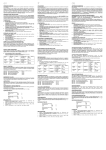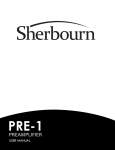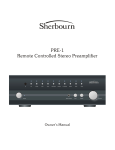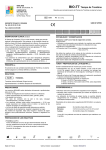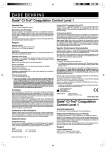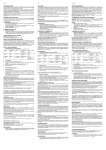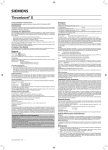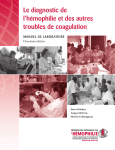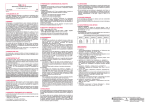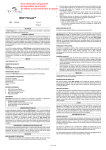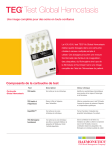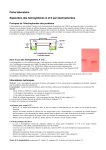Download en fr de
Transcript
en fr de INTENDED PURPOSE UTILISATION ANWENDUNGSBEREICH Thrombin Reagent is intended for use in the quantitative determination of fibrinogen in human plasma using the Clauss Method. Clauss1 developed a simple method for the quantitative determination of fibrinogen by measuring the clotting time of dilute plasma after the addition of thrombin (>30 NIH units/ml). This clot time is proportional to the fibrinogen concentration. Levels of fibrinogen can increase as a result of inflammation, pregnancy or oral contraceptive use2. Decreased levels can be found in certain states such as liver disease and DIC. Congenital deficiencies include afibrinogenaemia (no detectable fibrinogen), hypofibrinogenaemia (<1 mg/ml) and dysfibrinogenaemia (abnormal fibrinogen molecule). Le réactif Thrombine est utilisé pour la détermination quantitative du fibrinogène dans le plasma humain en utilisant la méthode de Clauss. Clauss1 a développé une méthode simple de détermination quantitative du fibrinogène en mesurant le temps de coagulation de plasma dilué après l’ajout de thrombine (>30 unités NIH/ml). Ce temps de coagulation est proportionnel à la concentration en fibrinogène. Le taux de fibrinogène peut augmenter en raison d’une inflammation, d’une grossesse ou de la prise de contraceptifs oraux2. Des taux diminués sont trouvés dans certaines pathologies comme une maladie du foie ou une CIVD. L’afibrinogénémie (pas de fibrinogène détectable), l’hypofibrinogénémie (<1 mg/ml) et la dysfibrinogénémie (molécule de fibrinogène anormale) sont des anomalies congénitales. Das Thrombin-Reagenz dient zum quantitativen Nachweis von Fibrinogen in Humanplasma nach der Methode nach Clauss. Clauss1 entwickelte zur quantitativen Bestimmung von Fibrinogen eine einfache Methode, bei der die Gerinnungszeit von verdünntem Plasma nach Zugabe von Thrombin gemessen wird (>30 NIH Einheiten/ml). Diese Gerinnungszeit ist der Fibrinogen-Konzentration direkt proportional. Das Fibrinogen kann durch Entzündung, Schwangerschaft oder Einnahme von oralen Verhütungsmitteln erhöht sein2. Vermindert wird es durch Lebererkrankung und Verbrauchskoagulopathie. Angeborene Mängelzustände sind insbesondere Afibrinogenämie (kein nachweisbares Fibrinogen), Hypofibrinogenämie (<1 mg/ml) und Dysfibrinogenämie (abnormales Fibrinogenmolekül). PRÉCAUTIONS WARNHINWEISE UND VORSICHTSMASSNAHMEN Les réactifs du kit sont à usage diagnostic in-vitro uniquement. NE PAS INGÉRER. Porter des gants pour la manipulation de tous les composants. Se reporter aux fiches de sécurité des composants du kit pour la manipulation et l’élimination. Un dépistage des produits à base de plasma a été réalisé et a donné un résultat négatif (sauf indication contraire sur la boîte du kit ou sur le flacon) pour les antigènes de l’hépatite B (AgHBs), les anticorps anti VIH 1 et 2 et les anticorps anti VHC ; il est malgré tout nécessaire de les manipuler avec les mêmes précautions que pour les échantillons de plasma humain. Die Reagenzien dieses Kits sind nur zur in-vitro Diagnostik bestimmt. – NICHT EINNEHMEN. Beim Umgang mit den Kit-Komponenten ist das Tragen von Handschuhen erforderlich. Siehe die Sicherheitsdatenblätter mit Gefahrenhinweisen und Sicherheitsvorschlägen sowie Informationen zur Entsorgung. Die Plasmaprodukte sind mit negativem Befund auf Hepatitis B Antigen (HBsAg), HIV-1 und HIV-2 Antikörper und HCV-Antikörper getestet worden (wenn nicht auf Kit-Verpackung oder Fläschchen anders bezeichnet). Sie sollten trotzdem mit derselben Vorsicht wie humane Plasmaproben behandelt werden. WARNINGS AND PRECAUTIONS The reagents contained in this kit are for in-vitro diagnostic use only - DO NOT INGEST. Wear gloves when handling all kit components. Refer to the product safety data sheets for risk and safety phrases and disposal information. Plasma products have been screened and found negative (unless otherwise stated on the kit box or vial) for the presence of Hepatitis B Antigen (HbsAg) HIV 1 and 2 antibody and HCV antibody; however they should be handled with the same precautions as a human plasma sample. COMPOSITION 1. 2. Thrombin Reagent REF 5374 (10 x 2ml) REF 5378 (10 x 5ml) Each vial contains approximately 100 NIH units/ml bovine thrombin with stabilisers. Preparation: Reconstitute each vial with 2.0ml (for Cat. No. 5374) or 5.0ml (for Cat. No. 5378) of purified water. Swirl gently and allow to stand for 15 minutes. Mix well before use. Do not shake. Other kit components Each kit contains Instructions For Use. COMPOSITION 1. 2. STORAGE AND SHELF-LIFE Unopened vials are stable until the given expiry date when stored under conditions indicated on the vial or kit label. 1. Thrombin Reagent Once reconstituted, the reagent is stable for 8 hours at room temperature or 1 week at 2...6°C. ITEMS REQUIRED BUT NOT PROVIDED Cat. No. 5379 Fibrinogen Calibrator 10 x 1ml or Cat. No. 5185 SARP 10 x 1ml Cat. No. 5375 Owren’s Veronal Buffer 10 x 25ml Plastic or siliconised glass should be used throughout. Blood (9 parts) should be collected into 3.2% or 3.8% sodium citrate anticoagulant (1 part). Separate plasma after centrifugation at 2000 - 3000 x g for 15 minutes. Plasma should be kept at 2…6°C. Testing should be completed within 2 hours of sample collection, or plasma can be stored frozen at -20°C for 2 weeks or -70°C for one month. Thaw quickly at 37°C prior to testing. Do not keep at 37°C for more than 5 minutes. STEP BY STEP PROCEDURE Helena BioSciences Thrombin reagent is suitable for use on any coagulation analyser capable of performing Clauss Fibrinogen assays. Refer to the Instrument Operators Manual and/or application note for appropriate instructions. Prepare all reagents as instructed under ‘composition’.. 1. Standard Curve Preparation Note: A new standard curve should be used when reagent lot numbers change or if expected values in quality control testing change. Prepare the following dilutions in Owren’s Veronal Buffer: 2. 3. a) b) c) d) Les flacons non ouverts sont stables jusqu’à la date de péremption indiquée s’ils sont conservés dans les conditions indiquées sur l’étiquette du kit ou du flacon. 1. Réactif Thrombine Une fois reconstitué, le réactif est stable 8 heures à température ambiante ou 1 semaine entre 2...6°C. Fibrinogen Calibrator (ml) 0.2 0.1 0.1 0.1 0.1 Buffer (ml) 0.8 0.9 1.9 2.9 3.9 Mix without shaking. Patient Sample Preparation Prepare 1+9 dilutions of the patient plasma or control plasma in Owren’s Veronal Buffer. Mix without shaking. Testing Perform all tests in duplicate. Pipette 0.2ml of standard, patient or control dilution into a reaction tube and incubate at 37°C for 2 minutes. Add 0.1ml of Thrombin Reagent 15...30°C. Determine the clot time to the nearest 0.1 seconds. Plot mean Standard Clot Time (Y-axis) versus Fibrinogen Level (X-axis) on the Fibrinogen graph paper. A straight line should be obtained. Assign the Fibrinogen Calibrator reference value to the 1+9 dilution to allow direct interpolation of patient and control values from the standard curve. PROBENENTNAHME UND VORBEREITUNG MÉTHODOLOGIE SCHRITT-FÜR-SCHRITT METHODE Le réactif Thrombine Helena BioSciences est approprié pour être utilisé avec un analyseur de la coagulation pouvant réaliser le dosage du fibrinogène de Clauss. Se référer au manuel d’utilisation de l’instrument et/ou aux notes d’application pour avoir des instructions appropriées. Das Helena BioSciences Thrombin-Reagenz kann mit jedem Gerinnungs-Analyzer verwendet werden, mit dem man Fibrinogen-Bestimmungen nach Clauss durchführen kann. Zur Bedienung siehe Bedienungsanleitung des Geräts und/oder Anwenderhinweise. Préparer tous les réactifs en suivant les indications du paragraphe ‘Composition’. 1. Préparation de la courbe d’étalonnage REMARQUE: Il faut utiliser une nouvelle courbe d’étalonnage lorsque vous utilisez un nouveau numéro de lot de réactif ou si les valeurs prévues dans le contrôle qualité changent. Préparer les dilutions suivantes du tampon Véronal de Owren: Alle Reagenzien wie unter „Inhalt“ beschrieben vorbereiten. 1. Erstellung der Standardkurve Bitte beachten: Für jede neue Reagenzien-Charge, oder wenn sich die Normalwerte der Qualitätskontrolle ändern, muss eine neue Standardkurve erstellt werden. Folgende Verdünnungen mit Owrens Veronal-Puffer herstellen: Tube 1 2 3 4 5 2. 3. a) b) c) d) Dilution 1+4 1+9 1+19 1+29 1+39 Étalon Fibrinogène(ml) 0.2 0.1 0.1 0.1 0.1 Mélanger sans agiter. Préparation de l’échantillon patient Préparer des dilutions 1+9 du plasma du patient ou du plasma de contrôle avec du tampon Véronal de Owren. Mélanger sans agiter. Analyse Réaliser toutes les analyses en double. Pipeter 0,2ml de dilution étalon, patient ou contrôle dans un tube à essai et incuber à 37°C pendant 2 minutes. Ajouter 0,1 ml de réactif Thrombine 15...30°C. Déterminer le temps de coagulation en arrondissant au dixième de seconde. Tracer une courbe avec le temps moyen de coagulation de l’étalon (en ordonnée) et le taux de fibrinogène (en abscisse) sur le papier millimétré du fibrinogène. Vous devez obtenir une ligne droite. Assigner la valeur de référence de l’étalon Fibrinogène à la dilution 1+9 afin de réaliser une interpolation directe des valeurs patient et contrôle à partir de la courbe d’étalonnage. Helena BioSciences distribue les contrôles suivants à utiliser avec ce produit: REF 5301 Plasma de contrôle normal SAC-1 10 x 1 ml REF 5302 Plasma de contrôle anormal SAC-2 10 x 1 ml REF 5186 Plasma de contrôle Norm-Trol 1 10 x 1 ml REF 5187 Plasma de contrôle Ab-Trol 2 10 x 1 ml REF 5183 Plasma de contrôle Ab-Trol 3 10 x 1 ml LIMITATIONS Heparin levels >0.6 units/ml and fibrinolytic degredation products >100mg/ml may cause falsely low fibrinogen quantitation. If values fall outside the standard curve values for the patient samples, re-assay using an appropriate dilution to bring values into the standard range. PERFORMANCE CHARACTERISTICS Helena BioSciences or their representatives have determined the following performance characteristics as a guideline. Each laboratory should establish it’s own performance data. The Fibrinogen assay is designed to give a linear calibration from 1.5 - 6.5g/L. REPRODUCIBILITY: Within assay reproducibility: Fibrinogen (g/L)=3.64 CV=4.87 n=10 Between assay reproducibility: Fibrinogen (g/L)=3.61 CV=3.78 n=10 BIBLIOGRAPHY Nur Plastik oder Silikonglas verwenden. Blut (9 Teile) sollte in 3,2% oder 3,8% Natriumcitrat als Antikoagulanz (1 Teil) entnommen werden. 15 Minuten bei 2000 3000g zentrifugieren und Plasma abpipettieren. Plasma bei 2...6°C lagern. Plasma sollte innerhalb von 2 Stunden verarbeitet werden oder kann tief gefroren bei -20°C 2 Wochen oder -70°C einen Monat gelagert werden. Vor dem Testen schnell bei 37°C auftauen. Nicht länger als 5 Minuten bei 37°C lassen. Tampon (ml) 0.8 0.9 1.9 2.9 3.9 REFERENCE VALUES Reference values can vary between laboratories depending on the techniques and systems in use. For this reason each laboratory should establish it's own normal range. Expected values for fibrinogen in healthy adults are 150-350 mg/dl (1.5-3.5 g/L)3,4. Helena BioSciences Europa bietet auch ein komplettes Fibrinogen Test-Kit an (Kat. Nr. 5376). Utiliser tout au long du prélèvement du plastique ou du verre siliconé. Mélanger 9 volumes de sang et 1 volume de citrate de sodium à 3,2% ou 3,8%. Séparer le plasma après centrifugation à 2000 - 3000 x g pendant 15 minutes. Conserver le plasma entre 2...6°C. L’analyse doit être terminée dans les 2 heures suivant le prélèvement de l’échantillon ; sinon, il est possible de congeler le plasma 2 semaines à -20°C ou un mois à -70°C. Décongeler rapidement à 37°C avant de réaliser l’analyse. Ne pas laisser à 37°C plus de 5 minutes. CONTRÔLE QUALITÉ 4. Ungeöffnete Fläschchen sind unter den auf Verpackung oder Fläschchen angegebenen Lagerbedingungen bis zum aufgedruckten Verfallsdatum stabil. 1. Thrombin-Reagenz Nach Rekonstitution ist das Reagenz 8 Stunden bei Raumtemperatur oder 1 Woche bei 2...6°C stabil. Kat. Nr. 5379 Fibrinogen-Kalibrator 10 x 1ml oder Kat. Nr. 5185 SARP 10 x 1ml Kat. Nr. 5375 Owrens Veronal-Puffer 10 x 25ml Helena BioSciences supply the following controls available for use with this product: REF 5301 Sac-1 Normal Control Plasma 10x1ml REF 5302 Sac-2 Abnormal Control Plasma 10x1ml REF 5186 Norm-Trol 1 Control Plasma 10x1ml REF 5187 Ab-Trol 2 Control Plasma 10x1ml REF 5183 Ab-Trol 3 Control Plasma 10x1ml 3. LAGERUNG UND STABILITÄT PRÉLÈVEMENTS DES ÉCHANTILLONS Each laboratory should establish a quality control program. Normal and abnormal control plasmas should be tested prior to each batch of patient samples, to ensure satisfactory instrument and operator performance. If controls do not perform as expected, patient results should be considered invalid. 2. 2. Thrombin-Reagenz REF 5374 (10 x 2ml) REF 5378 (10 x 5ml) Jedes Fläschchen enthält ca. 100 NIH-Einheiten / ml Rinder-Thrombin mit Stabilisatoren. Vorbereitung: Jedes Fläschchen mit 2,0ml (für Kat. Nr. 5374) oder 5,0ml (für Kat. Nr. 5378) destilliertem Wasser rekonstituieren. Leicht schwenken und 15 Minuten stehen lassen. Vor Gebrauch gut mischen. Nicht schütteln. Weitere Kit-Komponenten Jedes Kit enthält eine Gebrauchsanweisung. NICHT MITGELIEFERTES, ABER BENÖTIGTES MATERIAL Réf. 5379 Étalon Fibrinogène 10 x 1ml ou Réf. 5185 SARP 10 x 1ml Réf. 5375 Tampon Véronal de Owren 10 x 25ml QUALITY CONTROL 1. 1. STOCKAGE ET CONSERVATION Helena BioSciences Europe distribue aussi un kit complet de dosage du fibrinogène, réf. 5376. SAMPLE COLLECTION AND PREPARATION Dilution 1+4 1+9 1+19 1+29 1+39 INHALT MATÉRIELS NÉCESSAIRES NON FOURNIS Helena BioSciences Europe also provides the complete Fibringoen Assay kit, Cat. No. 5376. Tube 1 2 3 4 5 Réactif Thrombine REF 5374 (10 x 2ml) REF 5378 (10 x 5ml) Chaque flacon contient environ 100 unités NIH/ml de thrombine bovine additionnée de stabilisateurs. Préparation: Reconstituer chaque flacon avec 2,0ml (pour réf. 5374) ou 5,0ml (pour réf. 5378) d’eau distillée. Agiter doucement et laisser reposer 15 minutes. Bien mélanger avant utilisation. Ne pas agiter. Autres composants du kit Chaque kit contient une fiche technique. Chaque laboratoire doit établir un programme de contrôle qualité. Les plasmas de contrôle, normaux et anormaux, doivent être testés avant chaque lot d’échantillons patients afin de s’assurer que l’instrument et l’opérateur offrent des performances satisfaisantes. Si les contrôles ne donnent pas les résultats prévus, les résultats du patient doivent être considérés comme non valables. VALEURS DE RÉFÉRENCE Les valeurs de référence peuvent varier d’un laboratoire à l’autre suivant les techniques et les systèmes utilisés. C’est pour cette raison qu’il appartient à chaque laboratoire de déterminer sa propre plage normale. Le taux prévu de fibrinogène chez un adulte sain est de 150–350 mg/dl (1,5–3,5 g/l)3,4. LIMITES Röhrchen 1 2 3 4 5 2. 3. a) b) c) d) Verdünnung 1+4 1+9 1+19 1+29 1+39 Fibrinogen-Kalibrator (ml) 0.2 0.1 0.1 0.1 0.1 Puffer (ml) 0.8 0.9 1.9 2.9 3.9 Ohne zu schütteln mischen. Vorbereitung der Patientenprobe Eine 1+9 Verdünnung des Patienten- oder Kontrollplasmas mit Owrens Veronal-Puffer herstellen. Ohne zu schütteln mischen. Testdurchführung Alle Tests im Doppelansatz durchführen. 0,2ml Standard, Patienten- oder Kontrollverdünnung in ein Röhrchen pipettieren und bei 37°C 2 Minuten inkubieren. 0,1ml Thrombin-Reagenz 15...30°C hinzufügen. Die Gerinnungszeit bis auf 0,1 Sekunden genau bestimmen. Den Mittelwert der Standardgerinnungszeit (Y-Achse) gegen Fibrinogen-Wert (X-Achse) auf Fibrinogen-Millimeterpapier auftragen. Es sollte eine gerade Linie erzielt werden. Den Referenzwert des Fibrinogen-Kalibrators der 1+9 Verdünnung zuordnen, um eine direkte Interpolation von Patienten- und Kontrollwerten aus der Standardkurve zu ermöglichen. QUALITÄTSKONTROLLE Jedes Labor muss für eine eigene Qualitätskontrolle sorgen. Vor jeder Testreihe mit Patientenproben müssen normale und pathologische Kontrollplasmen getestet werden, um eine zufrieden stellende Geräteleistung und Bedienung zu gewährleisten. Liegen die Kontrollen außerhalb des Normbereichs, sind die Patientenergebnisse nicht zu verwenden. In Verbindung mit diesem Produkt bietet Helena BioSciences die folgenden Kontrollen an: REF 5301 Sac-1 Normal Kontroll-Plasma 10 x 1 ml REF 5302 Sac-2 Abnormal Kontroll-Plasma 10 x 1 ml REF 5186 Norm-Trol 1 Kontroll-Plasma 10 x 1 ml REF 5187 Ab-Trol 2 Kontroll-Plasma 10 x 1 ml REF 5183 Ab-Trol 3 Kontroll-Plasma 10 x 1 ml REFERENZWERTE Referenzwerte können je nach Technik und verwendetem System von Labor zu Labor unterschiedlich sein. Aus diesem Grund sollte jedes Labor seinen eigenen Normalwertbereich erstellen. Fibrinogen-Normalwerte bei gesunden Erwachsenen sind 150-350mg/dl (1,5-3,5 g/l)3,4. Des taux d’héparine >0,6 unités/ml et de produits de dégradation fibrinolytique >100mg/ml peuvent donner une quantification du fibrinogène erronément basse. Si les valeurs de l’échantillon patient se situent hors des valeurs de la courbe d’étalonnage, réaliser à nouveau l’analyse en utilisant la dilution appropriée pour les amener dans la plage de l’étalon. EINSCHRÄNKUNGEN Heparinwerte >0,6 Einheiten/ml und Fibrinolyse-Abbauprodukte >100mg/ml können falsch niedrige Fibrinogen-Mengen ergeben. Liegen bei Patientenproben die Werte außerhalb der Standardkurve, die Proben erneut mit verdünntem Plasma testen, um die Werte in den Bereich der Standardkurve zu bringen. PERFORMANCES LEISTUNGSEIGENSCHAFTEN Die folgenden Leistungseigenschaften wurden von Helena BioSciences oder in ihrem Auftrag als Richtlinien ermittelt: Jede Labor muss seine eigenen Werte ermitteln. Der Fibrinogen-Test ist so konzipiert, dass sich eine lineare Kalibration von 1,5 – 6,5g/l ergibt. Helena BioSciences ou ses représentants ont déterminé à titre indicatif les performances suivantes. Chaque laboratoire doit établir ses propres données de performance. Le dosage du fibrinogène est conçu pour donner un étalonnage linéaire sur la plage 1,5 – 6,5 g/l. Reproduzierbarkeit: REPRODUCTIBILITÉ: Clauss, A.,’Gerinnungsphysiologische Schnell-methode zur bestimmung des Fibrinogens’ Acta Haematol., 1957, 17 : 237-246. Shaw, T.S.,’Assays for Fibrinogen and its Derivatives’ CRC Crit. Rev. Clin. Lab. Sci., 1977, 8 : 145-192. Scully, R.E. et al.,’Normal Reference Laboratory Values’, N. Eng. J. Med., 1980, 302(37) : 37-48. Okuno, T. and Selenko, V., Amer. J. Med. Tech., 1972, 38(6) : 196-201. Reproductibilité intra-analyse: Fibrinogène (g/l)=3,64 CV=4,87 n=10 Reproductibilité inter-analyse : Fibrinogène (g/l)=3,61 CV=3,78 n=10 BIBLIOGRAPHIE 1. 2. 3. 4. Clauss, A.,’Gerinnungsphysiologische Schnell-methode zur Bestimmung des Fibrinogens’ Acta Haematol., 1957, 17 : 237-246. Shaw, T. S.,’Assays for Fibrinogen and its Derivatives’ CRC Crit. Rev. Clin. Lab. Sci., 1977, 8 : 145-192. Scully, R. E. et al.,’Normal Reference Laboratory Values’, N. Eng. J. Med., 1980, 302(37) : 37-48. Okuno, T. et Selenko, V., Amer. J. Med. Tech., 1972, 38(6) : 196-201. Reproduzierbarkeit innerhalb des Tests: Fibrinogen (g/l)=3.64 VK=4.87 n=10 Reproduzierbarkeit zwischen den Tests: Fibrinogen (g/l)=3.61 VK=3.78 n=10 LITERATUR 1. Clauss, A.,’Gerinnungsphysiologische Schnell-methode zur bestimmung des Fibrinogens’ Acta Haematol., 1957, 17 : 237-246. 2. Shaw, T.S.,’Assays for Fibrinogen and its Derivatives’ CRC Crit. Rev. Clin. Lab. Sci., 1977, 8 : 145-192. 3. Scully, R.E. et al.,’Normal Reference Laboratory Values’, N. Eng. J. Med., 1980, 302(37) : 37-48. 4. Okuno, T. and Selenko, V., Amer. J. Med. Tech., 1972, 38(6) : 196-201. it es PRINCIPIO USO PREVISTO Il reagente a base di trombina è stato formulato per la determinazione quantitativa del fibrinogeno in plasma umano utilizzando il metodo Clauss. Clauss1 ha messo a punto un semplice metodo per la determinazione quantitativa del fibrinogeno misurando il tempo di coagulazione del plasma diluito in seguito all’aggiunta di trombina (>30 NIH unità/ml). Questo tempo di coagulazione è proporzionale alla concentrazione di fibrinogeno. I livelli di fibrinogeno possono aumentare in seguito ad infiammazione, gravidanza o impiego di contraccettivi orali2. Livelli ridotti di fibrinogeno sono riscontrabili in alcuni stati, come ad esempio le patologie epatiche e la DIC. Tra le carenze congenite rientrano l’afibrinogenemia (assenza di fibrinogeno rilevabile), l’ipofibrinogenemia (<1 mg/ml) e la disfibrinogenemia (molecola di fibrinogeno anomala). El reactivo de trombina está previsto para su uso en la determinación cuantitativa del fibrinógeno en el plasma humano usando el método de Clauss. Clauss1 desarrolló un método simple para la determinación cuantitativa de fibrinógeno midiendo el tiempo de coagulación del plasma diluido después de la adición de trombina (>30 unidades NIH/ml). Este tiempo de coagulación es proporcional a la concentración de fibrinógeno. Los niveles de fibrinógeno pueden aumentar como consecuencia de inflamación, embarazo o uso de anticonceptivos orales2. Pueden encontrarse niveles disminuidos en determinados estados como la hepatopatía y la CID. Entre las deficiencias congénitas están la afibrinogenemia (sin fibrinógeno detectable), la hipofibrinogenemia (<1mg/ml) y la disfibrinogenemia (molécula de fibrinógeno anormal). AVVERTENZE E PRECAUZIONI ADVERTENCIAS Y PRECAUCIONES I reagenti contenuti in questo kit sono destinati esclusivamente alla diagnostica in vitro - NON INGERIRE. Indossare guanti protettivi durante l’uso dei componenti del kit. Fare riferimento alle istruzioni del prodotto per avvertenze su rischi e sicurezza ed informazioni sullo smaltimento dei componenti. I prodotti plasmatici sono stati esaminati dando esito negativo (salvo diversamente indicato sulla confezione del kit o sul flacone) relativamente alla presenza dell’antigene dell’epatite B (HbsAg), dell’anticorpo anti-HIV 1 e 2 e dell’anticorpo anti-HCV; questi prodotti devono tuttavia essere manipolati con le stesse misure precauzionali adottate per un campione di plasma umano. Los reactivos contenidos en este kit son sólo para uso diagnóstico NO SE DEBEN INGERIR. Usar guantes para manejar todos los componentes del kit. Consultar la hoja con los datos de seguridad del producto acerca de los riesgos, avisos de seguridad y consejos para su eliminación. Los productos plasmáticos se han sometido a pruebas y han resultado negativos (a menos que se indique otra cosa en la caja del kit o en el vial) para la presencia de antígeno de la hepatitis B (HbsAg), anticuerpos de VIH 1 y 2 y anticuerpo del VHC; sin embargo, deben manipularse con las mismas precauciones que una muestra de plasma humano. COMPOSIZIONE COMPOSICIÓN 1. 1. 2. Reagente a base di trombina REF 5374 (10 x 2ml) REF 5378 (10 x 5ml) Ogni flacone contiene approssimativamente 100 NIH unità/ml di trombina bovina con stabilizzatori. Preparazione: Ricostituire ogni flacone con 2,0ml (per Cod. N. 5374) o 5,0ml (per Cod. N. 5378) di acqua distillata. di acqua distillata. Agitare delicatamente e lasciare riposare per 15 minuti. Miscelare accuratamente prima dell’uso. Non scuotere. Altri componenti del kit Ogni kit contiene un foglio procedurale. CONSERVAZIONE E STABILITÀ I flaconi non aperti sono stabili fino alla data di scadenza indicata se conservati nelle condizioni riportate sul flacone o sull’etichetta del kit. 1. Reagente a base di trombina Dopo la ricostituzione, il reagente è stabile per 8 ore a temperatura ambiente o per 1 settimana a 2...6°C. 2. Reactivo de trombina REF 5374 (10 x 2ml) REF 5378 (10 x 5ml) Cada vial contiene aproximadamente 100 unidades NIH/ml de trombina bovina con estabilizadores. Preparación: Reconstituir cada vial con 2,0ml (para el Nº Cat. 5374) o 5,0ml (para el Nº Cat. 5378) de agua destilada. Agitar suavemente y permitir que repose durante 15 minutos. Mezclar bien antes de usar. No agitar. Otros componentes del kit Cada kit contiene instrucciones de uso. ALMACENAMIENTO Y PERÍODO DE VALIDEZ Los viales no abiertos son estables hasta la fecha de caducidad indicada cuando se conservan en las condiciones indicadas en el vial o en la etiqueta del kit. 1. Reactivo de trombina El reactivo reconstituido permanece estable durante 8 horas a temperatura ambiente o 1 semana a 2...6 °C. ARTÍCULOS NECESARIOS NO SUMINISTRADOS MATERIALI NECESSARI, MA NON IN DOTAZIONE Nº Cat. 5379 Calibrador del fibrinógeno 10 x 1 ml o Nº Cat. 5185 SARP 10 x 1 ml Nº Cat. 5375 Tampón Veronal de Owren 10 x 25 ml Cod. N. 5379 Calibratore per fibrinogeno 10 x 1ml oppure Cod. N. 5185 SARP 10 x 1ml Cod. N. 5375 Tampone Veronal di Owren 10 x 25ml Helena BioSciences Europe fornisce anche il kit di dosaggio del fibrinogeno completo, Cod. N. 5376.N. 5376. Nel corso dell’intera procedura è necessario utilizzare plastica o vetro siliconizzato. Il sangue (9 parti) deve essere raccolto in sodio citrato al 3,2% o al 3,8% come anticoagulante (1 parte). Separare il plasma in seguito a centrifugazione a 2000 3000 x g per 15 minuti. Il plasma deve essere conservato a 2...6°C. I test devono essere completati entro 2 ore dalla raccolta dei campioni; in alternativa, il plasma può essere conservato congelato a -20°C per 2 settimane o a -70°C per 1 mese. Decongelare rapidamente a 37°C prima di eseguire il test. Non conservare a 37°C per oltre 5 minuti. Instructions for use REF 5374 (200 tests) 10 X 2ml REF 5378 (500 tests) 10 X 5ml Réactif Thrombine Fiche technique Thrombin-Reagenz Anleitung Helena BioSciences Europe también proporciona el kit de Valoración del Fibrinógeno completo, Nº Cat. 5376. RECOGIDA Y PREPARACIÓN DE MUESTRAS RACCOLTA DEI CAMPIONI E PREPARAZIONE Thrombin Reagent Deben usarse siempre plástico o vidrio siliconizado. Debe recogerse sangre (9 partes) en el anticoagulante citrato sódico al 3,2% o al 3,8% (1 parte). Se separa el plasma después de la centrifugación a 2000 - 3000 x g durante 15 minutos. El plasma debe conservarse a 2...6°C. Las pruebas deberían terminarse en 2 horas desde la recogida de las muestras o el plasma puede conservarse congelado a -20 °C durante 2 semanas o -70°C durante un mes. Descongelar rápidamente a 37°C antes de realizar la prueba. No conservar a 37 °C durante más de 5 minutos. Reagente a base di trombina Istruzioni per l’uso Reactivo de trombina Instrucciones de uso PROCEDIMIENTO PASO A PASO PROCEDURA Il reagente a base di trombina Helena BioSciences è idoneo all’uso in qualsiasi analizzatore di coagulazione in grado di eseguire i dosaggi del fibrinogeno di Clauss. Fare riferimento al manuale utente dello strumento e/o alla nota applicativa per conoscere le istruzioni specifiche. Preparare tutti i reagenti secondo le istruzioni riportate nel paragrafo COMPOSIZIONE. 1. Preparazione della curva standard NOTA: Quando i numeri di lotto dei reagenti cambiano o se i valori previsti per i test del controllo qualità variano, è necessario utilizzare una nuova curva standard. Preparare le seguenti diluizioni nel tampone Veronal di Owren: Provetta 1 2 3 4 5 Diluizione 1+4 1+9 1+19 1+29 1+39 Calibratore - fibrinogeno (ml) 0.2 0.1 0.1 0.1 0.1 El reactivo de trombina de Helena BioSciences es adecuado para usarse en cualquier analizador de coagulación capaz de realizar valoraciones del fibrinógeno de Clauss. Consúltese el Manual del Operador del Instrumento y/o la nota de aplicación para instrucciones adecuadas. Prepare todos los reactivos como se indica en “composición”. 1. Preparación de la curva estándar NOTA: Debe usarse una nueva curva estándar cuando los números de lote de los reactivos cambian o si los valores esperados en las pruebas de control de calidad cambian. Prepare las siguientes diluciones en Tampón Veronal de Owren. Tubo 1 2 3 4 5 Tampone (ml) 0.8 0.9 1.9 2.9 3.9 2. 2. 3. a) b) c) d) Miscelare senza scuotere. Preparazione dei campioni dei pazienti Preparare 1+9 diluizioni di plasma del paziente o di plasma di controllo nel tampone Veronal di Owren. Miscelare senza scuotere. Esecuzione del test Eseguire tutti i test per 2 volte. Pipettare 0,2ml di diluizione standard, del paziente o di controllo in una provetta di reazione ed incubare a 37°C per 2 minuti. Aggiungere 0,1ml di reagente a base di trombina 15...30°C. Determinare il tempo di coagulazione con un’approssimazione a 0,1 secondi. Tracciare il tempo di coagulazione standard medio (sull’asse Y) rispetto al livello di fibrinogeno (sull’asse X) sulla carta diagrammata del fibrinogeno. Si dovrà ottenere una linea retta. Assegnare il valore di riferimento del calibratore per fibrinogeno alla diluizione 1+9, per consentire l’interpolazione diretta dei valori del paziente e di controllo dalla curva standard. CONTROLLO QUALITÀ Ogni laboratorio deve definire un programma di controllo qualità. I plasmi di controllo normali e anormali devono essere testati prima di ogni lotto di campioni di pazienti, per garantire un livello prestazionale soddisfacente sia per quanto riguarda lo strumento che per l’operatore. Qualora i controlli non funzionassero come previsto, i risultati relativi ai pazienti dovranno essere considerati non validi. Helena BioSciences mette a disposizione i seguenti controlli utilizzabili con questo prodotto: REF 5301 Sac-1 Plasma di controllo normale 10x1ml REF 5302 Sac-2 Plasma di controllo anormale 10x1ml REF 5186 Norm-Trol 1 Plasma di controllo 10x1ml REF 5187 Ab-Trol 2 Plasma di controllo 10x1ml REF 5183 Ab-Trol 3 Plasma di controllo 10x1ml VALORI DIRIFERIMENTO I valori di riferimento possono variare da un laboratorio all’altro in funzione delle tecniche e dei sistemi in uso. Per tale motivo ciascun laboratorio dovrà elaborare un proprio range normale. Nei soggetti adulti sani i valori previsti per il fibrinogeno sono di 150-350 mg/dl (1,5-3,5 g/L)3,4. 3. a) b) c) d) Diluciones 1+4 1+9 1+19 1+29 1+39 Calibrador del fibrinógeno (ml) 0.2 0.1 0.1 0.1 0.1 Tampón (ml) 0.8 0.9 1.9 2.9 3.9 Mezclar sin agitar. Preparación de la muestra del paciente Preparar 1 + 9 diluciones del plasma del paciente o el plasma control en tampón Veronal de Owren. Mezclar sin agitar. Realización de las pruebas Realizar todas las pruebas por duplicado. Pipetear 0,2 ml de solución estándar, del paciente o control en un tubo de reacción e incubar a 37°C durante 2 minutos. Añadir 0,1 ml de reactivo de trombina 15...30°C. Determinar el tiempo de coagulación en los 0,1 segundos más próximos. Dibujar el tiempo de coagulación estándar (eje Y) frente al nivel del fibrinógeno (eje X) en el papel de gráfico del fibrinógeno. Debe obtenerse una línea recta. Asignar el valor de referencia del calibrador del fibrinógeno a la dilución 1 + 9 para permitir la interpolación directa de los valores del paciente y control a partir de la curva estándar. CONTROL DE CALIDAD Cada laboratorio debe establecer un programa de control de calidad. Los controles normales y anormales deben estudiarse antes de cada lote de muestras del paciente, para asegurar un funcionamiento adecuado del instrumento y el operador. Si los controles no se realizan como se esperaba, los resultados del paciente deben considerarse inválidos. Helena BioSciences suministra los siguientes controles disponibles para usar con este producto: REF 5301 Plasma control normal Sac-1 10x1ml REF 5302 Plasma control anormal Sac-2 10x1ml REF 5186 Plasma control Norm-Trol 1 10x1ml REF 5187 Plasma control Ab-Trol 2 10x1ml REF 5183 Plasma control Ab-Trol 3 10x1ml VALORES DE REFERENCIA Los valores de referencia pueden variar entre los laboratorios dependiendo de las técnicas y sistemas usados. Por esta razón, cada laboratorio debe establecer su propio intervalo normal. Los valores esperados para el fibrinógeno en adultos sanos son de 150-350 mg/dl (1,5-3,5 g/l)3,4. LIMITACIONES LIMITAZIONI I livelli di eparina >0,6 unità/ml e i prodotti fibrinolitici di degradazione >100mg/ml possono causare una quantificazione del fibrinogeno falsamente bassa. Se i valori fuoriescono dai valori della curva standard per i campioni dei pazienti, ripetere il dosaggio utilizzando una diluizione appropriata per portare i valori all’interno del range standard. Los niveles de heparina >0,6 unidades/ml y los productos de degradación fibrinolíticos >100mg/ml pueden producir una cuantificación falsamente baja del fibrinógeno. Si los valores caen fuera de los valores de la curva estándar para las muestras de pacientes, vuelva a realizar la valoración usando una dilución adecuada para llevar los valores al intervalo estándar. CARACTERÍSTICAS FUNCIONALES CARATTERISTICHE PRESTAZIONALI Le caratteristiche prestazionali sotto riportate sono state determinate da Helena BioSciences o dai propri rappresentanti a titolo di linee guida. Ciascun laboratorio dovrà pertanto elaborare i propri dati prestazionali. Il dosaggio del fibrinogeno è stato studiato per fornire una calibrazione lineare compresa tra 1,5 e 6,5g/L. Helena BioSciences o sus representantes han determinado las siguientes características de rendimiento como directriz. Cada laboratorio debe establecer sus propios datos de rendimiento. La valoración del fibrinógeno está diseñada para dar una calibración lineal de 1,5 a 6,5 g/l. REPRODUCTIBILIDAD: RIPRODUCIBILITÀ: Reproducibilidad dentro de cada ensayo: Fibrinógeno (g/l)=3.64 CV=4.87 n=10 Riproducibilità entro il dosaggio: Fibrinogeno (g/L)=3.64 CV=4.87 n=10 Riproducibilità tra i dosaggi: Fibrinogeno (g/L)=3.61 CV=3.78 n=10 Reproducibilidad entre distintos ensayos: Fibrinógeno (g/l)=3.61 CV=3.78 n=10 BIBLIOGRAFÍA BIBLIOGRAFIA 1. 2. 3. 4. Clauss, A.,’Gerinnungsphysiologische Schnell-methode zur bestimmung des Fibrinogens’ Acta Haematol., 1957, 17 : 237-246. Shaw, T.S.,’Assays for Fibrinogen and its Derivatives’ CRC Crit. Rev. Clin. Lab. Sci., 1977, 8 : 145-192. Scully, R.E. et al.,’Normal Reference Laboratory Values’, N. Eng. J. Med., 1980, 302(37) : 37-48. Okuno, T. and Selenko, V., Amer. J. Med. Tech., 1972, 38(6) : 196-201. 1. 2. 3. 4. Clauss, A.,’Gerinnungsphysiologische Schnell-methode zur Bestimmung des Fibrinogens’ Acta Haematol., 1957, 17 : 237-246. Shaw, T.S.,’Assays for Fibrinogen and its Derivatives’ CRC Crit. Rev. Clin. Lab. Sci., 1977, 8 : 145-192. Scully, R.E. et al.,’Normal Reference Laboratory Values’, N. Eng. J. Med., 1980, 302(37) : 37-48. Okuno, T. and Selenko, V., Amer. J. Med. Tech., 1972, 38(6) : 196-201. Helena Biosciences Europe Queensway South Team Valley Trading Estate Gateshead Tyne and Wear NE11 0SD Tel. +44 (0)191 482 8440 Fax +44 (0)191 482 8442 Email [email protected] www.helena-biosciences.com HL-2-0651P 2008/04 (7)


